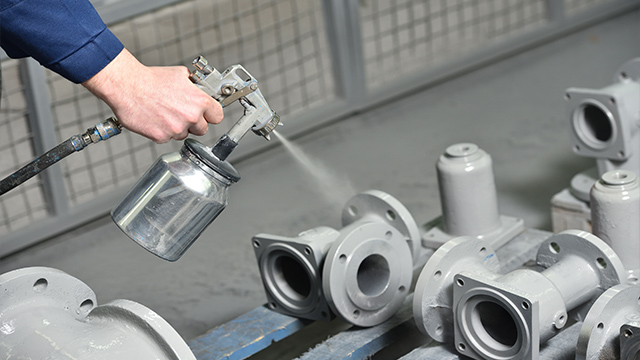How Do Casting Factories Prevent Rust on Cast Iron?
2025-01-03 10:36:36 hits:0
In the production and storage processes of casting factories, preventing rust on cast iron is of crucial importance as it is closely related to product quality and subsequent performance. Here are some common and effective anti-rust methods.
I. Surface Coating Protection Methods
- Paint Coating: This is the most basic and widely used method. Casting factories usually select industrial paints with good weather resistance and strong adhesion, such as alkyd paints and epoxy paints. After the cast iron parts are carefully ground to remove surface impurities and oil stains, multiple layers of paint are evenly sprayed. Take the shell of a large cast iron machine as an example. Generally, a primer is first applied. The primer can penetrate into the tiny pores on the surface of the casting to enhance adhesion. After the primer is completely dried and cured, 2 - 3 layers of topcoat are sprayed. The topcoat forms a dense protective film, effectively isolating air and water vapor to prevent rusting. This method has a relatively low cost and is suitable for general cast iron products with less strict appearance requirements.
- Galvanizing Treatment: For some small cast iron parts used outdoors and with certain requirements for conductivity, galvanizing is an ideal choice. Through the hot-dip galvanizing process, the cast iron parts are completely immersed in the high-temperature molten zinc liquid, causing a reaction between zinc and the cast iron surface to form a zinc-iron alloy layer and a pure zinc layer. This composite coating not only blocks the erosion of oxygen and moisture, but also, due to the sacrificial anode protection characteristic of zinc, when the coating is damaged, zinc will corrode preferentially to protect the cast iron substrate. For example, the cast iron connectors of outdoor power facilities, after hot-dip galvanizing, can have an anti-rust period of up to several years in complex and changeable natural environments. You may wonder “do cast irons rust” in such situations, and the answer is yes, but with proper galvanizing, rust can be effectively prevented.
II. Chemical Anti-Rust Agent Treatment Methods
- Water-based Anti-rust Agent Soaking: Casting factories often use water-based anti-rust agents during the short-term inventory or turnover stage of products. The cleaned cast iron parts are immersed in a water-based anti-rust agent solution containing components such as sodium nitrite and sodium borate. These chemicals can form an adsorptive protective film on the cast iron surface to inhibit the electrochemical corrosion process. For instance, some precision cast iron molds, while temporarily stored in the workshop waiting for the next production batch, are immersed in the water-based anti-rust agent, which can ensure that there is no rust on the surface within several weeks. And when they are used subsequently, only a simple cleaning is required before putting them into production, without affecting the dimensional accuracy and surface quality. If you are concerned about “how to remove rust off cast iron” in case of any accidental rust, proper soaking in the right anti-rust agent can help.
- Volatile Corrosion Inhibitor (VCI) Paper Packaging: For some high-value-added and easily rusted precision cast iron components, VCI paper packaging is a high-end protection method. The VCI paper contains volatile corrosion inhibitors, such as dicyclohexylamine nitrite. When the cast iron parts are wrapped with this special paper, the corrosion inhibitor slowly volatilizes, filling the enclosed space with anti-rust gas molecules that adsorb on the cast iron surface to form an invisible protective layer and block the rusting conditions. Some small cast iron parts in the aerospace field, when packaged with VCI paper, can still maintain a good initial state even when stored in a relatively humid environment for a long time. If you want to know “how to keep cast iron from rusting” or “how do you keep cast iron from rusting” in a similar way, VCI paper packaging is a great option.
III. Environmental Control Methods
Casting factories pay attention to the control of the storage environment, trying to minimize humidity and temperature fluctuations to reduce the causes of cast iron rusting. On the one hand, warehouses with dehumidification functions are built. By installing dehumidifiers, the indoor relative humidity is controlled between 40% and 60% all year round to prevent water vapor from condensing on the cast iron surface. For example, during the plum rain season in the south, dehumidifiers can effectively remove the excess water in the air to ensure the safety of the cast iron products in the warehouse. On the other hand, the warehouse layout is reasonably planned to avoid direct contact between cast iron parts and the ground or walls. Shelves, pallets and other measures are used for elevation and isolation. At the same time, the warehouse is kept well ventilated so that the air circulation can take away the possible moisture, reducing the risk of rusting from the source.
In conclusion, casting factories comprehensively use the above-mentioned multiple anti-rust methods according to the types, uses and storage durations of cast iron products to maximize the anti-rust effect of cast iron products in the whole process of production, transportation and storage, and provide customers with high-quality and durable products. If you are still curious about “how do you get rust off of cast iron” when dealing with rusted cast iron, there are also other effective methods like scrubbing with steel wool, using vinegar soak, etc. But prevention is always better than cure, and proper anti-rust measures should be taken in advance.

 en
en  fra
fra  de
de  ru
ru  gle
gle  th
th  ara
ara  it
it  jp
jp  kor
kor  zh
zh 



